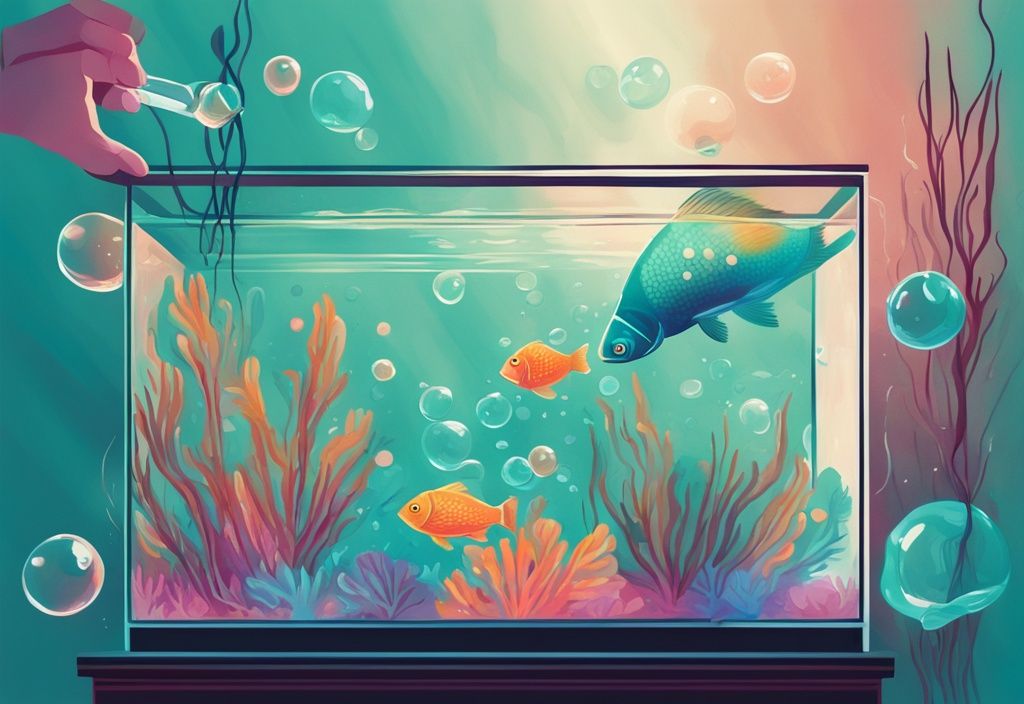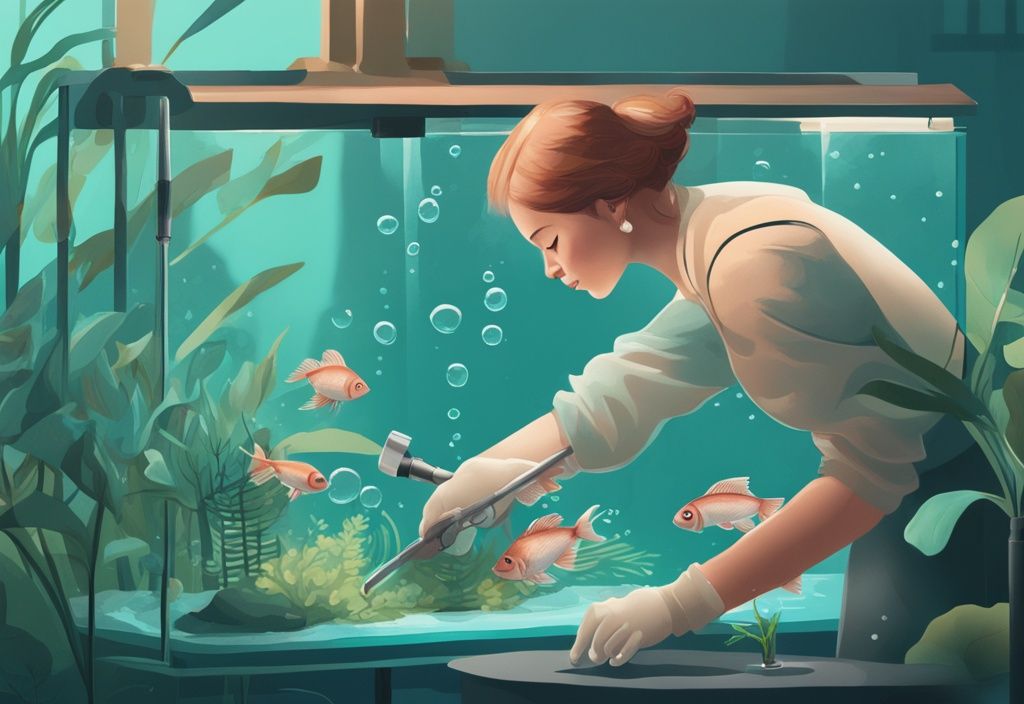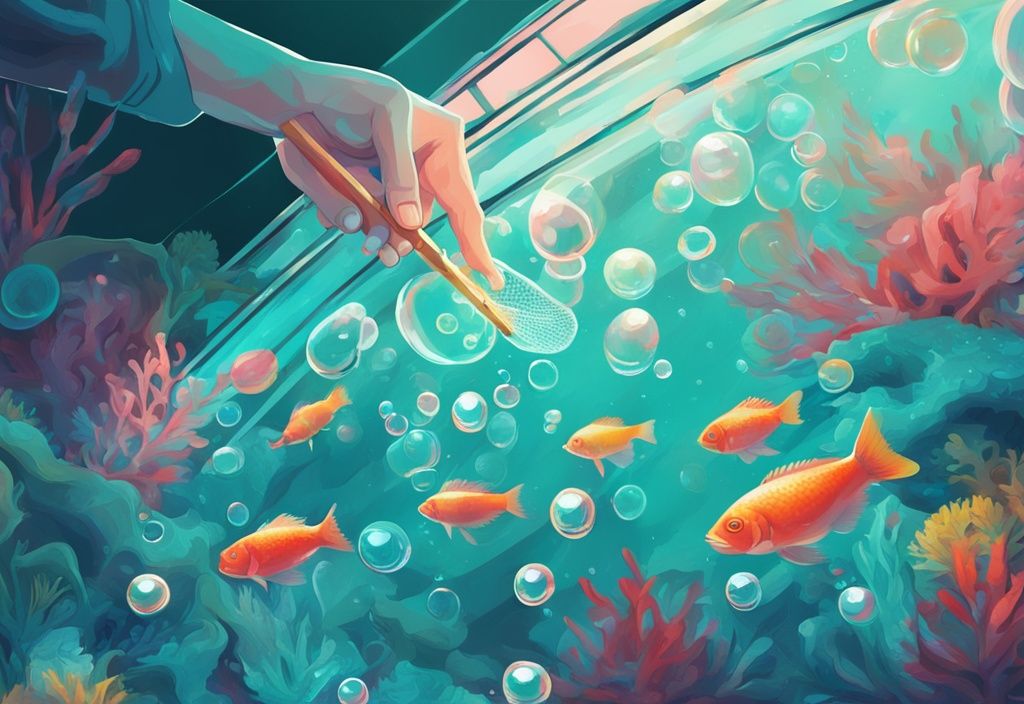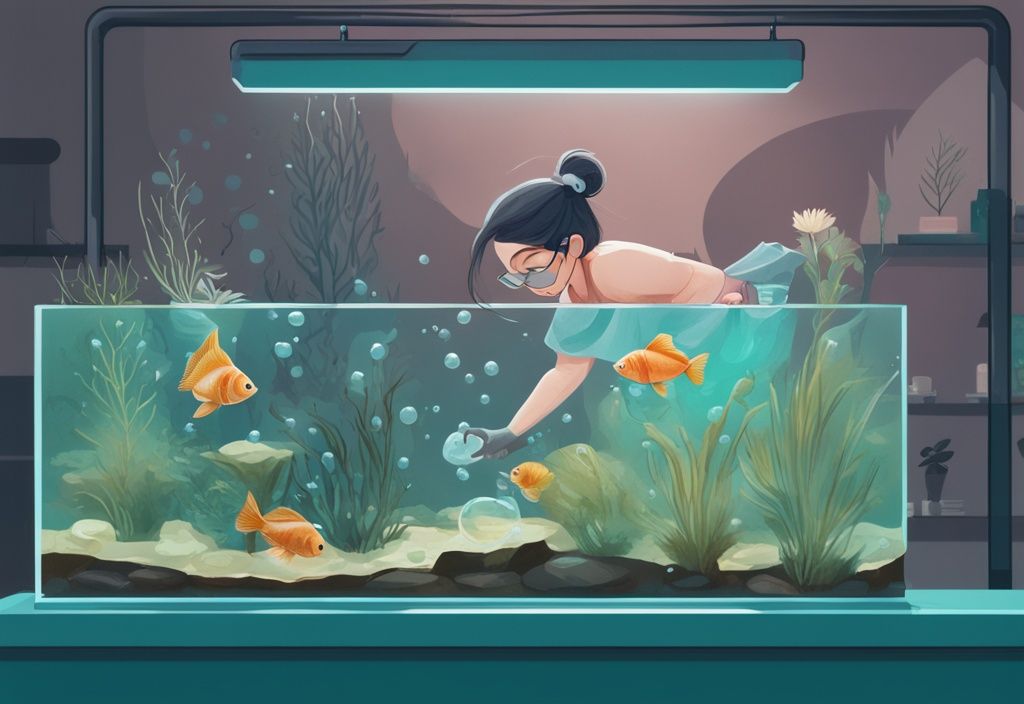As an avid marine biologist, let me assure you, seeing bubbles on top of your fish tank is enough to ruffle any aquarium enthusiast’s feathers. But why do they appear? And crucially, how can you get rid of them? We’re about to explore that mystery together.
This bubbling issue may be as benign as harmless surfactant residue, or could potentially indicate more serious concerns like decaying organic matter. In this practical guide, I shall distill my 20 years of hands-on experience into helping you identify the cause, eliminate the bubbles, and take preventive measures.
By the end of this comprehensive guide, not only will your fish tank stay bubble-free, but the clarity of your aquatic environment will also noticeably improve. So, shall we dive in?
Identifying the Cause of Bubbles in Your Fish Tank
Surface bubbles in your fish tank can emerge due to a variety of reasons ranging from the presence of soap residue to the natural behavior of fish. To understand how to get rid of bubbles on top of fish tank, evaluate any recent changes within the tank environment.
These changes could include the addition of new equipment, the use of water additives, or the introduction of new fish. Careful observation of the type and consistency of bubbles can provide significant clues: foamy bubbles often indicate the presence of high protein content, whereas larger, sporadic bubbles might be the result of mechanical agitation.
Differentiating Harmful and Harmless Bubbles
Not all bubbles in your fish tank are harmful. Bubbles produced by air pumps or CO2 diffusers are generally harmless and do not require intervention. However, bubbles that form persistently and create a film on the water surface may suggest the presence of unwanted substances such as protein or soap, and these will need to be addressed immediately.
Additionally, some bubbles are a result of natural fish behavior. For instance, male labyrinth fish, such as bettas, create bubble nests as a part of their mating ritual. These nests are entirely normal and are actually a sign of healthy and active fish.
Understanding these distinctions is crucial in learning how to get rid of bubbles on top of fish tank effectively, ensuring the health and well-being of your aquatic pets.
Easy Techniques to Remove Bubbles
When searching for how to get rid of bubbles on top of the fish tank, manual surface skimming is a swift and effective method. It efficiently eliminates unwanted bubbles, ensuring your tank remains pristine and visually appealing.
Using Simple Household Items for Bubble Skimming
Numerous household items can be effectively employed to skim bubbles off the surface of your fish tank. Below are some techniques to address this issue using common items found in most homes.
Cup or Plate Skimming Technique
One effective approach involves using a clean cup or plate. Gently skimming the water surface with these items can catch and remove the bubble layer. Make sure the cup or plate is free from any contaminants, as introducing harmful substances to the tank can disrupt your aquarium’s balance.
Sponge or Mechanical Skimmer Method
A clean, unused sponge can also serve as an excellent tool for bubble removal.
By gently pressing the sponge against the water surface, you can soak up the bubbles. Additionally, mechanical skimmers offer a more automated solution. These devices, which can be attached to aquarium filters, work efficiently to skim off bubbles, maintaining the water’s clarity and the overall health of your aquatic environment.
Best Practices for Regular Tank Maintenance
Routine maintenance is crucial to prevent bubble-related issues and keep your fish tank in top condition.

Importance of Frequent Water Changes
Regular water changes play a fundamental role in keeping your aquarium clear and free from algae. In understanding how to get rid of bubbles on top of your fish tank, it’s important to realize that the primary cause is often excess proteins and waste materials. Conducting water changes of 10-20% weekly ensures these substances do not accumulate to problematic levels.
This consistent refreshment of water not only helps in removing dissolved organic compounds and pollutants but also supports the health of your fish and plants. Reducing these unwanted materials effectively lessens the likelihood of bubbles forming at the surface.
How Proper Filter Maintenance Can Prevent Bubbles
A well-maintained filter is the backbone of a bubble-free fish tank. Filters function as the main waste removal system, trapping debris and breaking down excess nutrients. Over time, filter media can become clogged with particles, reducing its efficiency.
Adhering to the manufacturer’s guidelines for cleaning or replacing filter media is essential to avoid protein buildups, a frequent cause of surface bubbles. A well-functioning filter ensures your water remains clean and stable, which is critical in tackling how to get rid of bubbles on top of a fish tank.
Importance of Gravel Cleaning to Reduce Bubbles
Gravel cleaning is another crucial aspect of tank maintenance for managing bubbles. Debris such as uneaten food, fish waste, and decaying plant matter often settle at the bottom, decomposing, and releasing proteins into the water.
Regularly vacuuming the gravel during water changes effectively removes this detritus, preventing it from contributing to bubble formation. Ensure thorough gravel cleaning each time to maintain a healthy substrate and prevent buildup that can lead to bubble issues.
By prioritizing these regular maintenance practices, you can keep your fish tank environment clean and minimize the occurrence of unwanted surface bubbles.
Water Quality and Chemistry Management
Maintaining proper water chemistry is essential for preventing bubble formation in your fish tank. Understanding how to manage water parameters and chemical additives can significantly reduce the presence of unwanted bubbles. Here are key practices to help you achieve optimal water quality and address how to get rid of bubbles on top of the fish tank.
Testing Water Parameters to Prevent Bubble Formation
Regularly testing your aquarium’s water parameters is crucial for maintaining a healthy environment and preventing bubble issues. Use high-quality test kits to monitor levels of ammonia, nitrite, and nitrate. Elevated ammonia levels can often lead to foaming on the surface. By conducting regular tests, you can quickly identify and address any imbalances.
Keeping these parameters within the safe range for your fish helps maintain overall water quality, thereby minimizing bubble formation. Adjust water chemistry as necessary based on your test results to ensure a stable and safe habitat for your aquatic creatures.
Managing Water Conditioners and Chemicals to Avoid Bubbles
Using water conditioners and other chemicals properly is vital for preventing excessive bubble buildup. Always follow the manufacturer’s guidelines when adding these products to your tank. Overdosing or misusing these chemicals can lead to unwanted bubbles on the surface.
Additionally, avoid using soap or any non-aquarium specific cleaning agents, as even residual traces can significantly contribute to surface bubbles. Opt for aquarium-safe products to clean your tank and equipment, ensuring no foreign substances that can cause harmful bubbles enter your water. Proper chemical management not only helps in how to get rid of bubbles on top of the fish tank but also promotes a healthier aquatic environment. For even better circulation and to enhance water quality, consider investing in the best aquarium wave maker suited for your tank.
Handling Bubbles Caused by Tank Decay and Waste
Decay and waste products can be significant contributors to bubbles on the surface of your fish tank. Addressing these issues is crucial for maintaining a clean and healthy aquatic environment. Here are some effective strategies on how to get rid of bubbles on top of fish tank caused by decay and waste.
Removing Decaying Biodegradable Components
Organic materials like plant matter and dead fish decompose over time, releasing proteins and other substances into the water that can cause bubble formation. To minimize this:
- Regular Inspection: Routinely check your tank for any decaying plant leaves, fallen debris, or dead fish. Promptly remove these to prevent them from breaking down and contributing to bubble formation.
- Decorations and Substrates: Tank decorations and substrates should be regularly monitored for bio-degradation. Clean and maintain these elements to ensure they do not become sources of decay.
Proper Fish Feeding Practices to Limit Bubble Formation
Overfeeding is a common mistake that can lead to an excess of waste products in the tank, thereby increasing protein levels and causing bubbles to form on the surface. Here’s how to manage feeding effectively:
- Controlled Portions: Feed your fish only what they can consume within a few minutes. This minimizes residual food that can decay and contribute to bubble formation.
- Remove Uneaten Food: After feeding, wait and observe. If any food remains uneaten, remove it promptly to reduce the risk of it decomposing and increasing protein levels in the water.

Natural Ways to Reduce Surface Bubbles
Employing natural methods can help reduce bubbles effectively and sustainably. These methods not only address the concern of unwanted bubbles but also enhance the overall health and aesthetics of your aquarium. Here are some natural approaches to minimize surface bubbles in your fish tank.
Using Floating Plants to Break Surface Tension
Floating plants are a simple and effective way to manage the issue of surface bubbles. By introducing plants like Water Lettuce or Duckweed into your tank, you can naturally disrupt surface tension, which helps in reducing bubble formation.
- Disrupting Surface Tension: Floating plants create physical barriers that break up the smooth surface of the water, making it less likely for bubbles to persist.
- Absorbing Nutrients: These plants absorb excess nutrients present in the water, thus preventing the buildup of proteins and other substances that contribute to bubble formation.
How a Mature Tank Biome Can Minimize Surface Bubbles
A mature tank with a well-established microbial biome can naturally control protein levels in the water. Patience and time are essential here, as new tanks are generally more prone to bubble-related issues until the ecosystem within the tank stabilizes.
- Stable Ecosystem: Over time, beneficial bacteria and microorganisms develop in your tank, creating a balanced ecosystem that effectively breaks down waste and proteins.
- Reduced Protein Levels: A mature biome efficiently manages waste products and reduces excess protein, thereby preventing persistent bubble formation.
- Time and Patience: It’s important to give your tank the necessary time to develop this stable environment. Regular care and maintenance during the initial setup phase can expedite this process.
By focusing on natural methods, aquarists can address the issue of how to get rid of bubbles on top of fish tanks in an eco-friendly and sustainable manner. Implementing these strategies not only enhances your tank’s appearance but also promotes a healthier habitat for your aquatic pets.
Common Aquarium Issues that Cause Surface Bubbles
Surface bubbles in your fish tank can indicate several underlying issues. Identifying these problems is crucial for maintaining a healthy aquatic environment and implementing effective solutions.
Why Too Much Light and High Temperature Cause Bubbles?
Excessive light in the aquarium can significantly increase the rate of photosynthesis in aquatic plants. This process leads to a higher release of oxygen into the water, which often manifests as bubbles on the surface. Proper light management can help mitigate this issue.
High temperatures play a large role in bubble formation due to their effect on surface tension. Warmer water has reduced surface tension, which makes bubbles linger longer on the surface. Keeping a stable and appropriate temperature for your aquarium’s inhabitants can prevent this problem. To address how to get rid of bubbles on top of fish tank caused by these factors, consider regulating the light exposure and maintaining optimal water temperatures.
The Role of Bubble Nests in Bubble Formation
Bubble nests are a natural part of some fish species’ behavior, particularly male labyrinth fish like Bettas. These nests are constructed by the male fish as part of their reproductive strategy and are entirely harmless.
Seeing bubble nests in your tank indicates a healthy, active fish engaged in normal behavior. While bubble nests do not pose a threat, understanding and recognizing them can prevent unnecessary interventions. If your goal is learning how to get rid of bubbles on top of fish tank, remember that bubble nests do not require removal but are signs of a thriving aquatic environment.

FAQ
Are Surface Bubbles Harmful to Fish?
Surface bubbles in your fish tank are not usually harmful to the fish. However, they often point to underlying water quality issues that may need your attention. Think of surface bubbles as a signal—like your car’s check engine light—that the tank’s environment might be off balance.
How Often Should I Change the Water to Prevent Bubbles?
To maintain optimal water quality and prevent bubble formation, perform a 10-20% water change on a weekly basis. This practice will help maintain a stable and clean environment for your fish, ensuring they thrive without the nuisance of surface bubbles.
Can Overfeeding Cause Bubbles on the Fish Tank Surface?
Indeed, overfeeding can result in excess waste and proteins in the water, creating an environment ripe for bubble formation. Feed your fish only what they can consume within a few minutes. Keeping this midday meal concise helps you avoid overfeeding and the subsequent bubble issues.
Does the Filtration System Cause Bubbles?
Filtration systems, especially those driven by air, can introduce bubbles into the tank. Adjusting the outflow or opting for filtration systems that don’t draw air into the water can significantly reduce surface bubbles. It’s all about tweaking until you find the perfect balance.
How Can I Adjust my Aquarium Settings to Minimize Bubbles?
To minimize surface bubbles, it’s crucial to maintain stable temperature, proper lighting, and efficient filtration. Regular maintenance is key—avoid overfeeding, and ensure aquarium decorations and equipment are thoroughly rinsed before use. By keeping these factors in check, you’ll foster a balanced and bubble-free environment.
Conclusion
The presence of bubbles on the surface of your fish tank is a common occurrence that can stem from a variety of causes, such as mechanical agitation or chemical imbalances. Recognizing and understanding these causes is crucial for determining how to get rid of bubbles on top of fish tank surfaces effectively.
Ensuring impeccable water quality is the cornerstone in mitigating bubble formation. Regularly test water parameters to maintain safe levels of ammonia, nitrite, and nitrate. Consistently adhere to weekly water changes, replacing 10-20% of the tank’s water to eliminate excess proteins and other substances contributing to bubble formation.
Routine maintenance of the filtration system also plays a vital role. A reliable and clean filter prevents protein buildup, further helping to reduce surface bubbles. Regular replacement or cleaning of filter media, as per manufacturer guidelines, ensures optimal filtration performance.
Addressing potential decay and waste is essential. Remove decaying plant matter, uneaten food, and dead fish promptly to prevent the decomposition processes that can increase protein levels in the water, causing persistent bubbling. Proper fish feeding practices can prevent overfeeding, which is a common source of excess waste and, consequently, surface bubbles.
Fostering a mature tank environment is another effective strategy. A well-established microbial biome in a mature tank helps control protein levels naturally, promoting better water quality. If you’re interested in learning more about creating the ideal tank environment, check out our guide on how to set up a fish tank. Employing natural methods such as introducing floating plants can disrupt surface tension and reduce bubble formation sustainably.
By following these practical tips, you can enjoy a bubble-free and healthy aquarium, ensuring optimal conditions for your aquatic pets. Implementing these strategies will help you maintain a visually appealing fish tank and provide a thriving environment for your fish.
Ensuring impeccable water quality is the cornerstone in mitigating bubble formation. Regularly test water parameters to maintain safe levels of ammonia, nitrite, and nitrate. Consistently adhere to weekly water changes, replacing 10-20% of the tank’s water to eliminate excess proteins and other substances contributing to bubble formation.
Routine maintenance of the filtration system also plays a vital role. A reliable and clean filter prevents protein buildup, further helping to reduce surface bubbles. Regular replacement or cleaning of filter media, as per manufacturer guidelines, ensures optimal filtration performance.
Addressing potential decay and waste is essential. Remove decaying plant matter, uneaten food, and dead fish promptly to prevent the decomposition processes that can increase protein levels in the water, causing persistent bubbling. Proper fish feeding practices can prevent overfeeding, which is a common source of excess waste and, consequently, surface bubbles.
Fostering a mature tank environment is another effective strategy. A well-established microbial biome in a mature tank helps control protein levels naturally, promoting better water quality. If you’re interested in learning more about creating the ideal tank environment, check out our guide on how to set up a fish tank. Employing natural methods such as introducing floating plants can disrupt surface tension and reduce bubble formation sustainably.
By following these practical tips, you can enjoy a bubble-free and healthy aquarium, ensuring optimal conditions for your aquatic pets. Implementing these strategies will help you maintain a visually appealing fish tank and provide a thriving environment for your fish.
